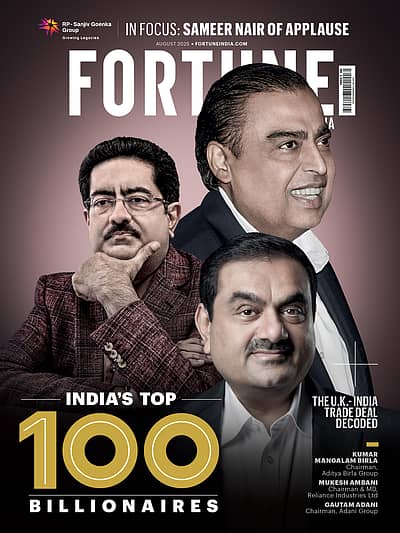From smart rings to smart socks: Nikhil Kamath’s tech roundtable uncovers India’s next $100M+ wearable market
ADVERTISEMENT

Within the domain of consumer electronics, the next big frontier seems to be health tech and wearables. In the latest episode of Nikhil Kamath 's WTF Is, the Zerodha co-founder spoke to tech industry heavyweights—Carl Pei of Nothing, Rahul Sharma of Micromax, and Amit Khatri of Noise—with the conversation peeling back layers of India’s tech boom, zeroing in on this next frontier.
The Health Tech Gold Rush
Amit Khatri kicked off the discussion with a bold prediction: health-focused wearables are poised to be the next big bet. Khatri, speaking to Kamath, spotlighted some niche innovations like wearable socks that monitor a child’s temperature and sleep patterns, as well as the rising popularity of smart rings among early adopters.
August 2025
As India continues to be the world’s fastest-growing major economy, Fortune India presents its special issue on the nation’s Top 100 Billionaires. Curated in partnership with Waterfield Advisors, this year’s list reflects a slight decline in the number of dollar billionaires—from 185 to 182—even as the entry threshold for the Top 100 rose to ₹24,283 crore, up from ₹22,739 crore last year. From stalwarts like Mukesh Ambani, Gautam Adani, and the Mistry family, who continue to lead the list, to major gainers such as Sunil Mittal and Kumar Mangalam Birla, the issue goes beyond the numbers to explore the resilience, ambition, and strategic foresight that define India’s wealth creators. Read their compelling stories in the latest issue of Fortune India. On stands now.
“These devices aren’t replacing smartwatches yet, but they’re carving out a dedicated niche,” Khatri noted. However, Khatri did add a caveat: while fitness trackers are flooding the market, most users aren’t leveraging them for actionable health insights.
For Khatri, the real challenge in this domain lay in democratizing advanced health tech like continuous glucose monitors (CGMs), which remain prohibitively expensive for the average Indian consumer.
“Apple might be pushing the envelope, but for mass adoption, we need affordable, non-invasive solutions—especially for the 35+ demographic,” he said.
Echoing Khatri, Carl Pei added that health tech isn’t the only sector with untapped potential.
“Parents are increasingly investing in tech-driven education tools for kids. The willingness to spend is there; the innovation just needs to catch up.”
The Data Behind the Boom
There is data to back this argument. According to the market intelligence firm IDC’s 2023 report, the wearable market grew by 34%, shipping a staggering 134.2 million units. Smartwatches led the charge with a 73.7% year-on-year surge, though heavy discounts drove average prices down by 38.7%. Earwear, meanwhile, saw modest growth, with TWS earbuds dominating at 67.3% market share.
Interestingly, the real dark horse turned out to be smart rings, exactly what Khatri had been advocating. Over 100,000 units were shipped in 2023, with Ultrahuman and Pi Ring battling for supremacy. However, the market isn’t without its pitfalls. The rise of cheap, unbranded knockoffs—bundled with multiple straps and flashy features—is diluting the user experience, forcing incumbents to rethink their strategies.
Offline vs. Online: The Retail Shakeup
One of the most surprising trends was the resurgence of offline sales, which grew 55.6% YoY as brands like Noise and BoAt expanded their retail footprint.
And the real beneficiary of this shift happens to be the legacy company, Titan. Titan’s climb to fourth place in smartwatches, as per IDC is all thanks to a multi-price-segment strategy and it proves that offline isn’t just surviving; it’s thriving.
The Road Ahead: Innovation or Commoditization?
As the conversation wrapped up, Kamath posed the million-dollar question: Is health tech the next battleground for consumer electronics? The consensus was clear: yes, but with caveats. Affordable, preventive care tools—think blood pressure monitors or sleep trackers—will drive the next wave, not just luxury CGMs. Pei summed it up best: “The Indian consumer is ready. Now, it’s on us to build devices they can’t live without.”
With giants like Noise and Nothing already placing their bets, one thing is certain—the wearable revolution is just getting started. And India will be the next big battleground for brands.
Fortune India is now on WhatsApp! Get the latest updates from the world of business and economy delivered straight to your phone. Subscribe now.
